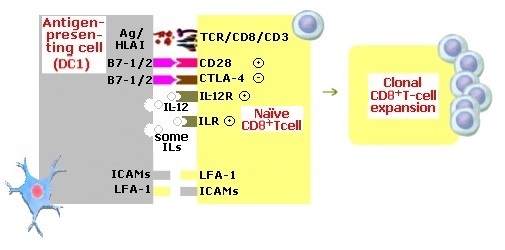|
|

ADAPTIVE IMMUNE RESPONSES
Recognition
P.C. Doherty (Australia, USA) (on the left) and R.M. Zinkernagel (Switzerland) won the 1996 Nobel Prize for their discoveries concerning the specificity of the cell-mediated immune defense ("dual recognition").
Typically, T cells participating in immune responses must receive three signals through:
(1) TCR ("dual recognition");
(2) costimulatory molecules, CD28 and ICOS; and
(3) pro-immunogenic cytokines in a set depending on a differentiation route of helper T cells.
See Figs. 1-3.
.jpg)
Fig. 1. Recognition by naïve CD4+ Ò cells (Th1)

Fig. 2. Recognition by naïve CD8+ Ò cells
.jpg)
Fig. 3. "Help" to naïve CD8+ Ò cells from Th1
Coinhibitory molecules for T cells are CTLA-4, PD-1, BTLA, and LAG-3.
B cells
B cells taking part in advanced immune response must also receive three signals through:
(1) BCR ("dual recognition");
(2) costimulatory molecules, CD40 plus CD30, and OX40L binding ligands on helper T cells; and
(3) pro-immunogenic cytokines.
See Fig. 4.
.jpg)
Fig. 4. Recognition by naïve B cells with "help" from Th2/Tfh
Coinhibitory molecules for B cells are almost the same as for T cells: CTLA-4, PD-1, BTLA, and LAG-3 plus CD22 and CD72.
©V.V.Klimov